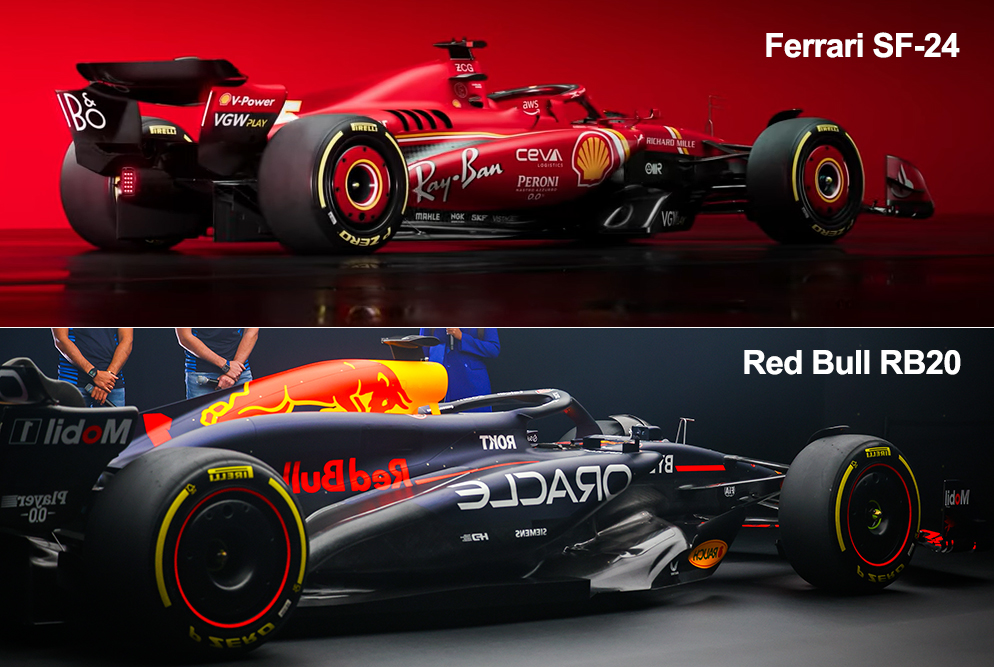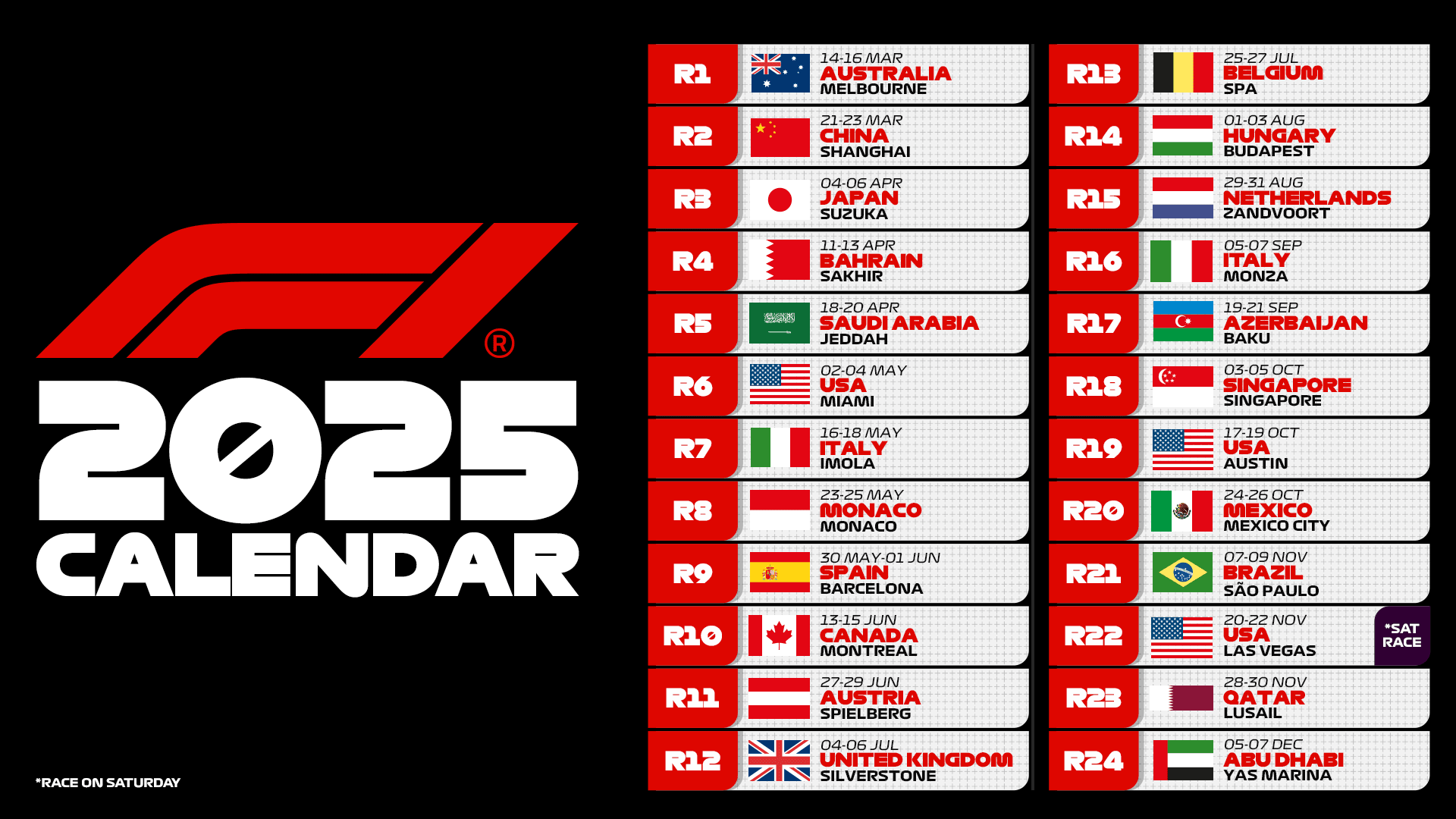The first four rounds of the 2024 Formula 1 championship, which were held in Bahrain, Saudi Arabia, Australia and Japan, have provided us with a fairly clear picture of the values in the field: Red Bull is always ahead, dominating. The RB20 car shows very few, if any, weaknesses and an extremely stable platform suitable for every track condition and layout. Behind it, the group has closed in. Not yet enough to challenge the Austrian side on equal terms, but at least capable of exploiting even the slightest imperfection of the team led by Christian Horner, as seen at the Albert Park circuit in Melbourne where Scuderia Ferrari achieved a memorable one-two finish benefiting from Max Verstappen’s retirement due to brake disk problems.
Many may wonder, how far are Ferrari, Mercedes, McLaren and Aston Martin from the Milton Keynes-based team? It is not easy to answer this question, but through data analysis, it is possible to try to gain some insight based on the results obtained by the teams in the early stages of the 2024 Formula 1 season. That’s why today’s F1 article focuses on the analysis of the so-called kilometric gap. As usual, some clarifications will be necessary before diving headlong into the data: the kilometric gap, in this case, is expressed as the difference from the pole position in terms of time (and therefore measured in seconds) divided by the length of the track in question, expressed in kilometers.
The unit of measurement, therefore, is seconds per kilometer. The dimensionless gap in terms of time over the length of the track allows us to disregard the clear differences between short and long circuits. It is no coincidence that a half-second gap recorded at Monte Carlo (a track of just 3 kilometers) assumes much greater significance than the same gap at Spa-Francorchamps, which is 7 kilometer long, precisely because the greater length of the track offers more physical space to make a difference. In turn, dividing the time difference by the length of the track helps us better contextualize the gaps.
Furthermore, the lap times considered for the analysis are the best ones set in the qualifying sessions regardless of the driver and session (Q1, Q2, Q3). In doing so, it is easier to gauge the real potential of the car, which sometimes a driver fails to unlock for various reasons. The focus has been on the top 5 teams of 2024. Using Red Bull as a benchmark (with the Austrian side having secured 4 poles out of 4), the reported gaps are those of Ferrari, McLaren, Mercedes and Aston Martin.
Ferrari:
The first peculiarity that certainly catches the eye is the negative gap recorded by Ferrari in Bahrain: in that situation, the SF-24 car showed itself to be extremely competitive during Q1 and Q2, enough to set the best times, only to struggle in Q3 and even worsen the times as compared to the previous mini-session. To be fair, few improved significantly their lap times between Q2 and Q3, including Red Bull, of course. However, curiously, Charles Leclerc’s Q2 time still turned out to be faster than the pole position set by Max Verstappen, the current leader of the Formula 1 championship.
This explains the red column extending negatively. These are nuances, as 14 milliseconds over 5.4 kilometers of track mark a gap per kilometer of just 0.0025 seconds per kilometer. In the first race of the season, the largest kilometric gap was recorded by McLaren, with about 0.08 seconds per kilometer difference. The papaya-colored team, not surprisingly, had struggled particularly in the opening race, still placing behind Mercedes and ahead of Aston Martin in the race. The black-silver arrows recorded just under 0.06 seconds per kilometer, while the AMR24 (which we’ll get used to calling Fernando Alonso’s Aston Martin throughout the article given the poor results and performance of his teammate) stood at around 0.07 seconds per kilometer.
Show your support for Scuderia Ferrari with official merchandise collection! Click here to enter the F1 online Store and shop securely! And also get your F1 tickets for every race with VIP hospitality and unparalleled insider access. Click here for the best offers to support Charles and Lewis from the track!
Show your support for Scuderia Ferrari with official merchandise collection! Click here to enter the F1 online Store and shop securely! And also get your F1 tickets for every race with VIP hospitality and unparalleled insider access. Click here for the best offers to support Charles and Carlos from the track!
The data from the first round of the 2024 Formula 1 campaign, rarely repeated itself similarly in the subsequent races, both because different cars performed better or worse on certain tracks, and because in the first four events, many Formula 1 teams brought innovations to their cars and, in general, “built” a useful knowledge base to optimize their current car packages, as was the case for Ferrari. Therefore, the analysis of the trend relative to the kilometric gap assumes greater value than the mere data itself. Now, let’s focus on other telemetry data that tracks the evolution of the gap in the various races of the 2024 racing campaign.
The colored solid lines connect the kilometric gaps for each Formula 1 race, while the dashed ones mark the average gap in the first sixth of the season. Observing the following image, it is very easy to notice how Ferrari has the smallest average gap of all, a factor that confirms what was seen on the track, with the Maranello team playing the role of Red Bull’s first pursuer. However, the trend of the SF-24 is increasing: after the excellent performance at the Bahrain International Circuit, the gap started to widen, stabilizing at the Jeddah circuit in Saudi Arabia and at the Albert Park circuit in Australia and undergoing a further downturn at the Suzuka circuit in the Japanese Grand Prix. But how can we explain this behavior?
It must be said that unlike teams like Red Bull and Aston Martin, Scuderia Ferrari has not yet introduced a serious package of innovations, preferring to optimize the current one and just making slight modifications to adapt to the various circuits based on the layout and the track characteristics. Furthermore, considering that the analysis takes into account the qualifying laps, it is confirmed that the Italian car struggles to activate the tires (as was clearly seen in Suzuka), and as a result, the gaps increase. The combination of these two factors helps explain the growing gap per kilometer in qualifying sessions, but it should be noted that if we were to evaluate race pace simulations, the trend would be quite different.
A reverse behavior is observed for McLaren: after a difficult race in Bahrain and a not very competitive qualifying at the Jeddah circuit, the MCL38 car bounces back with interest in Melbourne and at the Suzuka circuit. The Formula 1 layouts more congenial to the characteristics of the British car have helped a lot, so much so that in the recent Japanese stage, the English car recorded its minimum gap to Red Bull with just over 0.055 seconds per kilometer. Mercedes and Aston Martin show more detached and varied trends: for the team based in Brackley, the start of the 2024 Formula 1 season can be described as troubled at best.
The W15 single-seater doesn’t show the expected levels of downforce on the track, while tire degradation also leaves much to be desired. Thus, even on a single lap, the gaps are clearly there. After starting as the fourth force in Bahrain, Mercedes is relegated to fifth force in Saudi Arabia, with a gap of even seconds per kilometer. The situation worsens further at the Albert Park circuit in Australia, where it reaches tenth and a half per kilometer. Some small improvements were seen last time out in Suzuka, not so much in terms of positions, since the car was still slower than the AMR24, but at least in the gap from the leader, namely below 0.1 seconds per kilometer.
It’s not surprising that the difficult start of the 2024 Formula 1 championship determines the highest average gap of the teams in question, with the only one exceeding the tenth per kilometer barrier. Aston Martin, under Fernando Alonso’s leadership, put together its best weekend in Jeddah, where on a clean lap, it imposed itself as the third force behind Ferrari and Red Bull. In Melbourne, however, the worst AMR24 of the early season arrived, suffering a gap of more than 0.14 seconds per kilometer, but at least staying ahead of Mercedes. In view of the Japanese stage, an important package of innovations was introduced, mainly revolutionizing the car’s sidepods.
It can be said that this measure has worked, given that the single-lap pace was on par with the Maranello team and just behind the second force, McLaren. The whole group is on average closer to Red Bull, but what is most interesting is to note how compact the group of chasers is: in the first four races, we have seen the role of the first pursuer alternate twice, while Mercedes, McLaren, and Aston Martin have often exchanged the position of the tail light of the leading group. The substantial updates planned for the next two/three races will therefore become even more important, and will certainly involve Scuderia Ferrari but also Mercedes.
Ultimately, a reasoning already discussed in our previous articles finds confirmation today through the Formula 1 data analysis. The Prancing Horse shows a truly optimal race pace, as finally the management of the tires with a high fuel load on board is really good. Precisely for this reason, the Italian side is working to improve a distinctive trait that is limiting the achievement of the maximum goal in the race. We are referring precisely to the single lap pace in the qualifying session, where the SF-24 has proved to be less effective in terms of tire activation, as Ferrari has bot been able to fully exploit the potential of the car.

Source: for FUnoanalisitecnica












.png)

Leave a Reply